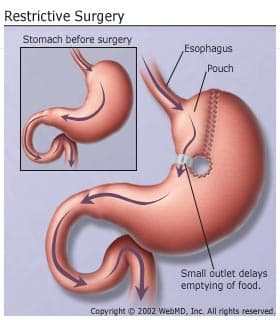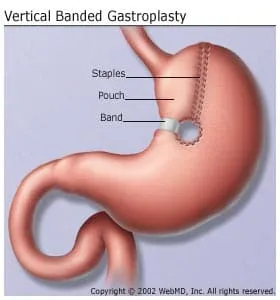Restrictive surgeries are used for producing weight loss. Food intake is restricted by creating a small pouch at the top of the stomach where the food enters from the esophagus. The pouch initially holds about 1 ounce of food and expands to 2-3 ounces with time. The pouch's lower outlet usually has a diameter of about 1/4 inch. The small outlet delays the emptying of food from the pouch and causes a feeling of fullness so you eat less.

Types of restrictive surgery for obesity include gastric banding and vertical banded gastroplasty (VBG) procedures. Both operations serve only to restrict food intake. They do not change the normal digestive process as does gastric bypass surgery.
What Is Vertical Banded Gastroplasty?
Also known as "stomach stapling," vertical banded gastroplasty (or VBG) was once a commonly used restrictive operation for weight loss. During the procedure, both a band and staples are used to create a small stomach pouch.
Other types of bariatric surgery have largely replaced the VGB procedure.

What Are the Risks Associated With Vertical Banded Gastroplasty?
Risks of VBG include:
- Erosion of the band used to create the stomach pouch
- Breakdown of the staple line used to create the stomach pouch
- Leakage of stomach juices into the abdomen, requiring an emergency operation
- In a very small number of people who get the surgery (less than 1%), infection or death from complications can occur.
- Possible nutrient or vitamin deficiency
What Is Gastric Banding?
During gastric banding, a band made of special material is placed around the stomach near its upper end, creating a small pouch and a narrow passage into the larger remainder of the stomach.

Gastric Sleeve Surgery
With gastric sleeve surgery, your surgeon will remove part of your stomach and join the remaining portions together to make a new banana-sized stomach or "sleeve." With just a small sack (about 1/10th the size of your original stomach), you'll feel full a lot quicker than you did before. The surgery removes the part of your stomach that makes a hormone that boosts your appetite.
What Are the Risks of Gastric Sleeve Surgery?
Risks of this surgery are also similar to those of gastric banding and VBG.
Risks of this surgery are also similar to those of gastric banding and VBG.
- Leakage of stomach juices along the staple line into the abdomen, requiring an emergency operation (rare)
- Stricture/stenosis (also rare)
- Bleeding
- Blood Clot
- Heartburn
- Possible nutrient or vitamin deficiency
What Are the Risks of Gastric Banding?
The risks associated with gastric banding are similar to the risks associated with VBG.
How Does Eating Change After Restrictive Surgery?
After restrictive surgery, you usually can eat only one-fourth to one-half cup of food without causing discomfort or nausea. Fluids are limited to small sips and should not be included with meals, since the new smaller stomach may not be large enough to hold fluid and food at the same time. Also, food has to be well chewed. For most people, the ability to eat a large amount of food at one time is lost. Therefore, it is necessary to eat several (eight to 10) small meals throughout the day to get enough nutrients. You’ll need to watch your nutrition and, in some cases, may need to take supplements and/or vitamins,
How Much Weight Can I Lose With Restrictive Surgery?
Restrictive surgery leads to significant weight loss in almost all patients. However, rates of weight loss vary, and weight regain does occur in some people.

